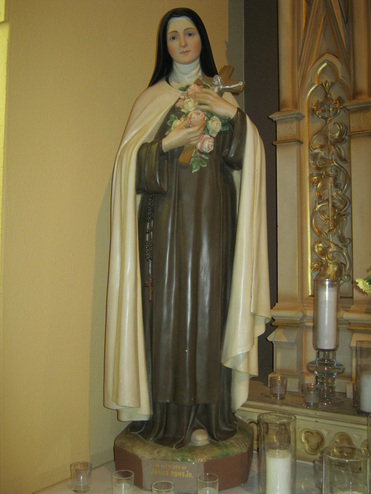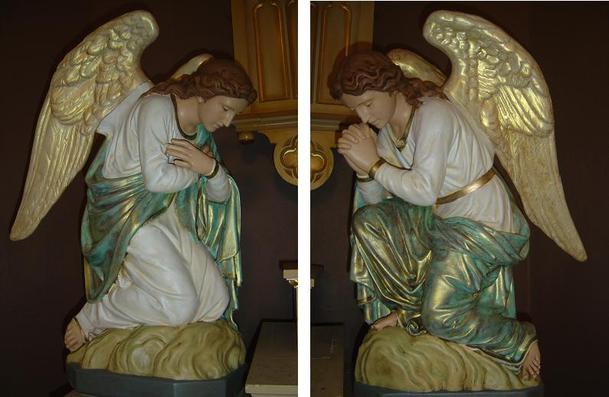St. Eloi Church Statues
The Sacred Heart of Jesus
Introduction to the Feast of the Sacred Heart of Jesus:
Devotion to the Sacred Heart of Jesus goes back at least to the 11th century, but through the 16th century, it remained a private devotion, often tied to devotion to the Five Wounds of Christ.
Quick Facts:
Date: 19 days after Pentecost Sunday; see When Is Feast of the Sacred Heart? for the date this year.
Type of Feast: Solemnity
Readings: Hosea 11:1, 3-4, 8c-9; Isaiah 12:2-3, 4, 5-6; Ephesians 3:8-12; John 19:31-37 (full text here)
Prayers: Act of Love to the Sacred Heart; Act of Consecration to the Sacred Heart
Other Names for the Feast: The Solemnity of the Most Sacred Heart of Jesus
History: The first feast of the Sacred Heart was celebrated on August 31, 1670, in Rennes, France, through the efforts of Fr. Jean Eudes (1602-1680). From Rennes, the devotion spread, but it took the visions of St. Margaret Mary Alacoque (1647-1690) for the devotion to become universal.
In all of these visions, in which Jesus appeared to St. Margaret Mary, the Sacred Heart of Jesus played a central role. The "great apparition," which took place on June 16, 1675, during the octave of the Feast of Corpus Christi, is the source of the modern Feast of the Sacred Heart. In that vision, Christ asked St. Margaret Mary to request that the Feast of the Sacred Heart be celebrated on the Friday after the octave (or eighth day) of the Feast of Corpus Christi, in reparation for the ingratitude of men for the sacrifice that Christ had made for them. The Sacred Heart of Jesus represents not simply His physical heart but His love for all mankind.
The devotion became quite popular after St. Margaret Mary's death in 1690, but, because the Church initially had doubts about the validity of St. Margaret Mary's visions, it wasn't until 1765 that the feast was celebrated officially in France. Almost 100 years later, in 1856, Pope Pius IX, at the request of the French bishops, extended the feast to the universal Church. It is celebrated on the day requested by our Lord-the Friday after the octave of Corpus Christi, or 19 days after Pentecost Sunday.
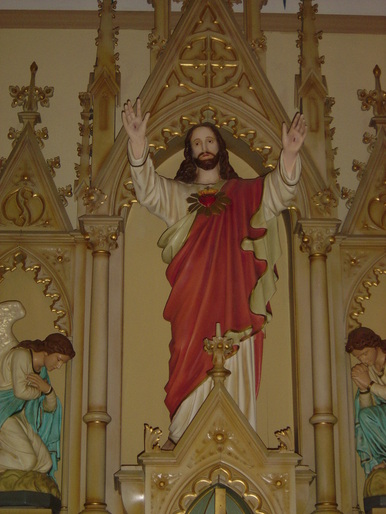

Blessed Virgin Mary, Mother of God
The Blessed Virgin Mary was born to St. Joachim and St. Anne, to be the famous WOMAN promised in the Proto-evangelium who would crush the head of the serpent. By being exempt from original sin and living a life in perfect fulfillment of the Will of God, She was visited by the Archangel Gabriel with this message:
"Hail Mary full of Grace, the Lord is with Thee.
Behold thou shalt conceive in thy womb, and shalt bring forth a son; and thou shalt call his name Jesus. He shall be great, and shall be called the Son of the most High; and the Lord God shall give unto him the throne of David his father; and he shall reign in the house of Jacob for ever. "
She conceived by the power of the Holy Spirit the Saviour of the world Our Lord Jesus Christ.
Our Lady lived a humble life as the Mother of Our Saviour, and as the spouse of St. Joseph, She lived the most virtuous life, and accompanied Jesus all the way to Calvary.
The Blessed Virgin Mary didn't die in the human way because She was exempt from original sin, and She was immaculate. She passed from this physical existence into the realm of the spirit in an ecstasy of love. The Fathers of the Church speak about her "dormition", and that after three days She was assumed in body and soul into Heaven.
She is the Queen of Heaven and the Queen of all Creation, her holiness surpasses the holiness of all the saints and angels put together. By her dignity of being the Mother of God, She is our advocate before Him and at the foot of the cross She was given to us in the person of John as our Mother.
"Behold your mother"
She is the woman clothed with the sun as portrayed in the Apocalypse, She is the New Jerusalem, the City of God, the Mountain of Zion so spoken of in the Holy Scriptures, She is the Living Tabernacle of the Divinity. A true devotion to the Blessed Virgin Mary will lead us to Jesus.
Her message is " Do whatever He tells you "
Feasts
1 January, Mother of God
2 February, Purification
25 March, Annunciation by Saint Gabriel
31 May, Visitation by Mary to Saint Elizabeth
2 August, Virgin of Los Angeles
15 August, Assumption into Heaven
8 September, Birthday; Feast of the Virgin of Charity
15 September, Feast of Our Lady of Sorrows
21 November, Presentation of Mary at the Temple
8 December, Mary's Immaculate Conception
Saint Joseph
The Story and History of Saint Joseph
The story and history of Saint Joseph. Joseph was by birth of the royal family of David, but was living in humble obscurity as a carpenter when God raised him to the highest sanctity, and fitted him to be the spouse of His Virgin Mother, and foster-father and guardian of the Incarnate Word. Joseph, says the Holy Scripture, was a just man; he was innocent and pure, as became the husband of Mary; he was gentle and tender, as one worthy to be named the father of Jesus; he was prudent and a lover of silence, as became the master of the holy house; above all, he was faithful and obedient to divine calls. His conversation was with angels rather than with men.
When he learned that Mary bore within her womb the Lord of heaven, he feared to take her as his wife; but an angel bade him fear not, and all doubts vanished. When Herod sought the life of the divine Infant, an angel told Joseph in a dream to fly with the Child and His Mother into Egypt. Joseph at once arose and obeyed. This sudden and unexpected flight must have exposed Joseph to many inconveniences and sufferings in so long a journey with a little babe and a tender virgin, the greater part of the way being through deserts and among strangers; yet he alleges no excuses, nor inquires at what time they were to return. St. Chrysostom observes that God treats thus all His servants, sending them frequent trials to clear their hearts from the rust of self-love, but intermixing seasons of consolation. "Joseph," says he, "is anxious on seeing the Virgin with child; an angel removes that fear. He rejoices at the Child's birth, but a great fear succeeds: the furious king seeks to destroy the Child, and the whole city is in an uproar to take away His life.
This is followed by another joy, the adoration of the Magi; a new sorrow then arises: he is ordered to fly into a foreign unknown country, without help or acquaintance." It is the opinion of the Fathers that upon their entering Egypt, at the presence of the child Jesus, all the oracles of that superstitious country were struck dumb, and the statues of their gods trembled and in many places fell to the ground. The Fathers also attribute to this holy visit the spiritual benediction poured on that country, which made it for many ages most fruitful in Saints.
After the death of King Herod, of which St. Joseph was informed in another vision, God ordered him to return with the Child and His Mother into the land of Israel, which our Saint readily obeyed. But when he arrived in Judea, hearing that Archelaus had succeeded Herod in that part of the country, and apprehensive that he might be infected with his father's vices, he feared on that account to settle there, as he would otherwise probably have done for the education of the Child; and therefore, being directed by God in another vision, he retired into the dominions of Herod Antipas, in Galilee, to his former habitation in Nazareth.
St. Joseph, being a strict observer of the Mosaic law, in conformity to its direction annually repaired to Jerusalem to celebrate the Passover. Our Saviour, now in the twelfth year of His age, accompanied His parents thither. Having performed the usual ceremonies of the feast, they were returning with many of their neighbors and acquaintances towards Galilee; and never doubting but that Jesus was with some of the company, they travelled on for a whole day's journey before they discovered that He was not with them. But when night came on and they could hear no tidings of Him among their kindred and acquaintance, they, in the deepest affliction, returned with the utmost speed to Jerusalem. After an anxious search of three days they found Him in the Temple, discoursing with the learned doctors of the law, and asking them such questions as raised the admiration of all that heard Him, and made them astonished at the ripeness of His understanding; nor were His parents less surprises on this occasion. When His Mother told Him with what grief and earnestness they had sought Him, and asked, "Son, why hast Thou thus dealt with us? behold Thy Father and I sought Thee in great affliction of mind," she received for answer, "How is it that you sought Me? did you not know that I must be about My Father's business?" But though thus staying in the Temple unknown to His parents, in all other things He was obedient to them, returning with them to Nazareth, and there living in all dutiful subjection to them. As no further mention is made of St. Joseph, he must have died before the marriage of Cana and the beginning of our divine Saviour's ministry.
Feast Day of Saint Joseph
The Feast Day of Saint Joseph is March 19. The origin of Feast Days: most saints have specially designated feast days and are associated with a specific day of the year and these are referred to as the saint's feast day. The feast days first arose from the very early Christian custom of the annual commemoration of martyrs on the dates of their deaths at the same time celebrating their birth into heaven.
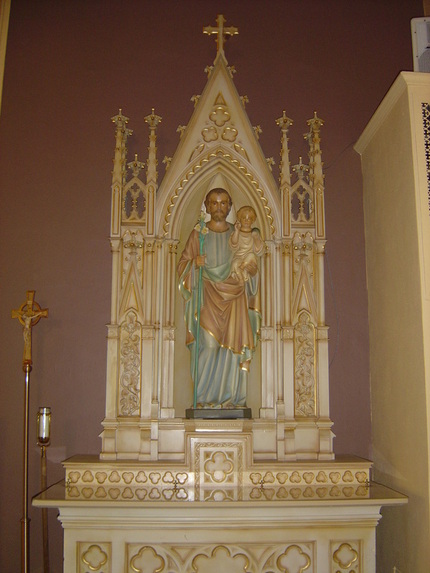
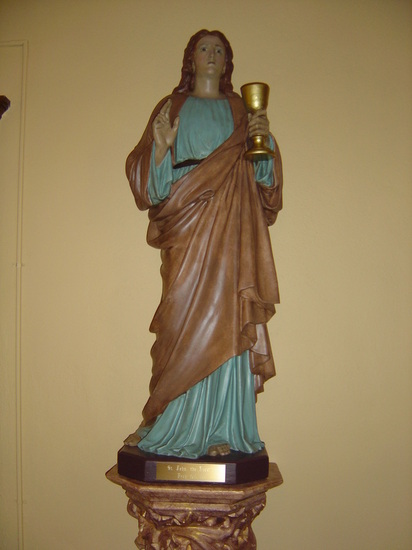
Saint John the Apostle
Feast Day: December 27
Saint John the Divine as the son of Zebedee, and his mother's name was Salome [Matthew 4:21, 27:56; Mark 15:40, 16:1]. They lived on the shores of the sea of Galilee. The brother of Saint John, probably considerably older, was Saint James. The mention of the "hired men" [Mark 1:20], and of Saint John's "home" [John 19:27], implies that the condition of Salome and her children was not one of great poverty.
SS. John and James followed the Baptist when he preached repentance in the wilderness of Jordan. There can be little doubt that the two disciples, whom Saint John does not name (John 1:35), who looked on Jesus "as he walked," when the Baptist exclaimed with prophetic perception, "Behold the Lamb of God!" were Andrew and John. They followed and asked the Lord where he dwelt. He bade them come and see, and they stayed with him all day. Of the subject of conversation that took place in this interview no record has come to us, but it was probably the starting-point of the entire devotion of heart and soul which lasted through the life of the Beloved Apostle.
John apparently followed his new Master to Galilee, and was with him at the marriage feast of Cana, journeyed with him to Capernaum, and thenceforth never left him, save when sent on the missionary expedition with another, invested with the power of healing. He, James, and Peter, came within the innermost circle of their Lord's friends, and these three were suffered to remain with Christ when all the rest of the apostles were kept at a distance [Mark 5:37, Matthew 17:1, 26:37]. Peter, James, and John were with Christ in the Garden of Gethsemane. The mother of James and John, knowing our Lord's love for the brethren, made special request for them, that they might sit, one on his right hand, the other on his left, in his kingdom [Matthew 20:21]. There must have been much impetuosity in the character of the brothers, for they obtained the nickname of Boanerges, Sons of Thunder [Mark 3:17, see also Luke 9:54]. It is not necessary to dwell on the familiar history of the Last Supper and the Passion. To John was committed by our Lord the highest of privileges, the care of his mother [John 19:27]. John [the "disciple whom Jesus loved"] and Peter were the first to receive the news from the Magdalene of the Resurrection [John 20:2], and they hastened at once to the sepulchre, and there when Peter was restrained by awe, John impetuously "reached the tomb first."
In the interval between the Resurrection and the Ascension, John and Peter were together on the Sea of Galilee [John 21:1], having returned to their old calling, and old familiar haunts.
When Christ appeared on the shore in the dusk of morning, John was the first to recognize him. The last words of the Gospel reveal the attachment which existed between the two apostles. It was not enough for Peter to know his own fate, he must learn also something of the future that awaited his friend. The Acts show us them still united, entering together as worshippers into the Temple [Acts 3:1], and protesting together against the threats of the Sanhedrin [Acts 4:13]. They were fellow-workers together in the first step of Church expansion. The apostle whose wrath had been kindled at the unbelief of the Samaritans, was the first to receive these Samaritans as brethren [Luke 9:54, Acts 8:14].
He probably remained at Jerusalem until the death of the Virgin, though tradition of no great antiquity or weight asserts that he took her to Ephesus. When he went to Ephesus is uncertain. He was at Jerusalem fifteen years after Saint Paul's first visit there [Acts 15:6]. There is no trace of his presence there when Saint Paul was at Jerusalem for the last time.
Tradition, more or less trustworthy, completes the history. Irenaeus says that Saint John did not settle at Ephesus until after the death SS. Peter and Paul, and this is probable. He certainly as not there when Saint Timothy was appointed bishop of that place. Saint Jerome says that he supervised and governed all the Churches of Asia. He probably took up his abode finally in Ephesus in 97. In the persecution of Domitian he was taken to Rome, and was placed in a cauldron of boiling oil, outside the Latin gate, without the boiling fluid doing him any injury. [Eusebius makes no mention of this. The legend of the boiling oil occurs in Tertullian and in Saint Jerome]. He was sent to labor at the mines in Patmos. At the accession of Nerva he was set free, and returned to Ephesus, and there it is thought that he wrote his gospel. Of his zeal and love combined we have examples in Eusebius, who tells, on the authority of Irenaeus, that Saint John once fled out of a bath on hearing that Cerinthus was in it, lest, as he asserted, the roof should fall in, and crush the heretic. On the other hand, he showed the love that was in him. He commended a young man in whom he was interested to a bishop, and bade him keep his trust well. Some years after he learned that the young man had become a robber. Saint John, though very old, pursued him among the mountain fastnesses, and by his tenderness recovered him.
In his old age, when unable to do more, he was carried into the assembly of the Church at Ephesus, and his sole exhortation was, "Little children, love one another."
The date of his death cannot be fixed with anything like precision, but it is certain that he lived to a very advanced age. He is represented holding a chalice from which issues a dragon, as he is supposed to have been given poison, which was, however, innocuous. Also his symbol is an eagle.
Saint Anne Mother of Mary
Memorial Day / Feast Day of Saint Anne: July 26
Description / Title of the Saint : Mother of Mary
Date of Death: Saint Anne died date unknown
The Story and History of Saint Anne
The story and history of Saint Anne. Saint Anne was the spouse of St. Joachim, and was chosen by God to be the mother of Mary, His own blessed Mother on earth. They were both of the royal house of David, and their lives were wholly occupied in prayer and good works. One thing only was wanting to their union - they were childless, and this was held as a bitter misfortune among the Jews. At length, when Anne was an aged woman, Mary was born, the fruit rather of grace than of nature, and the child more of God than of man. With the birth of Mary the aged Anne began a new life: she watched her every movement with reverent tenderness, and felt herself hourly sanctified by the presence of her immaculate child. But she had vowed her daughter to God, to God Mary had consecrated herself again, and to Him Anne gave her back. Mary was three years old when Anne and Joachim led her up the Temple steps, saw her pass by herself into the inner sanctuary, and then saw her no more. Thus was Anne left childless in her lone old age, and deprived of her purest earthly joy just when she needed it most. She humbly adored the Divine Will, and began again to watch and pray, till God called her to unending rest with the Father and the Spouse of Mary in the home of Mary's Child.
Prayer to Saint Anne
Feast Day of Saint Anne
The Feast Day of Saint Anne is July 26. The origin of Feast Days: most saints have specially designated feast days and are associated with a specific day of the year and these are referred to as the saint's feast day. The feast days first arose from the very early Christian custom of the annual commemoration of martyrs on the dates of their deaths at the same time celebrating their birth into heaven.
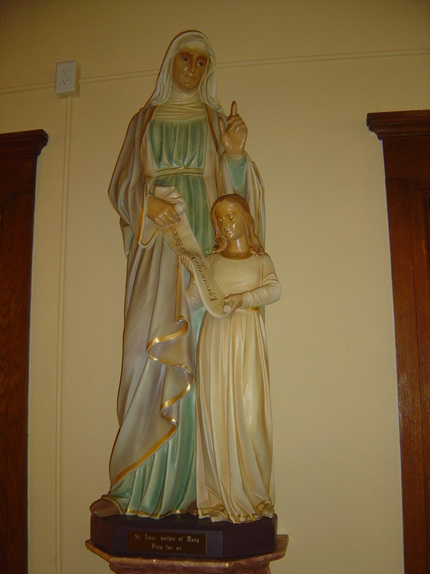
Angels
An angel is a pure spirit created by God. The Old Testament theology included the belief in angels: the name applied to certain spiritual beings or intelligences of heavenly residence, employed by God as the ministers of His will.
The English word "angel" comes from the Greek angelos, which means 'messenger'. In the Old Testament, with two exceptions, the Hebrew word for "angel" is malak, also meaning 'messenger'. The prophet Malachi took his name from this word. He was himself a messenger, and he prophesied about the coming of "the messenger of the covenant", Jesus Christ (Malachi 3:1).
Although the word "angel" in the Bible, meaning a messenger, nearly always applies to heavenly beings, it can occasionally apply to human messengers. Malachi himself said a priest was a messenger (malak) of the LORD of hosts (Malachi 2:7), and in the Book of Revelation the elders of the seven churches of Asia were called angels (1:20; 2:1 etc.). But when we meet messengers doing supernatural things, there is no doubt they are heavenly beings - God's messengers, working for Him and for the ultimate benefit of mankind.
For More information on Angels, see the Angel Link and the Angel Power pdf file below.
http://www.catholic.org/saints/angels/angelchoir.php
Seraphim
These are the highest order or choir of angels. They are the angels who are attendants or guardians before God's throne. They praise God, calling, "Holy Holy Holy is the Lord of Hosts". the only Bible reference is Isaiah 6:1-7. One of them touched Isaiah's lips with a live coal from the altar, cleansing him from sin. Seraphim have six wings, two cover their faces, two cover their feet, and two are for flying.
Cherubim
Cherubim rank after the seraphim and are the second highest in the nine hierarchies or choirs of angels. The Old Testament does not reveal any evidence that the Jews considered them as intercessors or helpers of God. They were closely linked in God's glory. They are manlike in appearance and double-winged and were guardians of God's glory. They symbolized then, God's power and mobility. In the New Testament, they are alluded to as celestial attendants in the Apocalypse (Rv 4-6). Catholic tradition describes them as angels who have an intimate knowledge of God and continually praise Him.
Thrones
Thrones are the Angels of pure Humility, Peace and Submission. They reside in the area of the cosmos where material form begins to take shape. The lower Choir of Angels need the Thrones to access God.
Dominions
Dominions are Angels of Leadership. They regulate the duties of the angels, making known the commands of God.
Virtues
Virtues are known as the Spirits of Motion and control the elements. They are sometimes referred to as "the shining ones." They govern all nature. They have control over seasons, stars, moon; even the sun is subject to their command. They are also in charge of miracles and provide courage, grace, and valor.
Powers
Powers are Warrior Angels against evil defending the cosmos and humans. They are known as potentates. They fight against evil spirits who attempt to wreak chaos through human beings. The chief is said to be either Samael or Camael, both angels of darkness.
Archangels
Archangels are generally taken to mean "chief or leading angel" ( Jude 9; 1 Thes 4:16), they are the most frequently mentioned throughout the Bible. They may be of this or other hierarchies as St. Michael Archangel, who is a princely Seraph. The Archangels have a unique role as God's messenger to the people at critical times in history and salvation (Tb 12:6, 15; Jn 5:4; Rv 12:7-9) as in The Annunciation and Apocalypse. A feast day celebrating the Archangels Michael, Gabriel and Raphael is celebrated throughout the Church Sep 29. A special part of the Byzantine Liturgy invokes the "Cherubic Hymn" which celebrates these archangels and the guardian angels particularly. Of special significance is St. Michael as he has been invoked as patron and protector by the Church from the time of the Apostles. The Eastern Rite and many others place him over all the angels, as Prince of the Seraphim. He is described as the "chief of princes" and as the leader of the forces of heaven in their triumph over Satan and his followers. The angel Gabriel first appeared in the Old Testament in the prophesies of Daniel, he announced the prophecy of 70 weeks (Dn 9:21-27). He appeared to Zechariah to announce the birth of St. John the Baptist (Lk 1:11). It was also Gabriel which proclaimed the Annunciation of Mary to be the mother of our Lord and Saviour. (Lk 1:26) The angel Raphael first appeared in the book of Tobit (Tobias)Tb 3:25, 5:5-28, 6-12). He announces "I am the Angel Raphael, one of the seven who stand before the throne of God." (Tb 12:15)
Principalities
In the New Testament Principalities refers to one type of spiritual (metaphysical) being which are now quite hostile to God and human beings. (Rom 8:38; 1 Cor 15:24; Eph 1:21; 3:10; 6:12; Col 1:16; 2:10, 15) Along with the principalities are the powers (Rom 8:38; 1 Cor 15:24; Eph 1:21; 1 Pt 3:22; 2 Thes 1:7); and cosmological powers (1 Cor 15:24; Eph 1:21; 3:10; Col 2:15);Dominions (Eph 1:21; Col 1:16) and thrones (Col1:16). The clarity of the New Testament witness helps see that these beings were created through Christ and for Him (Col 1:16). Given their hostility to God and humans due to sin, Christ's ultimate rule over them (ibid) expresses the reign of the Lord over all in the cosmos. This is the Lordship of Christ, which reveals God's tremendous salvation in conquering sin and death at the cross, and now takes place in the Church. (Eph 3:10)
Angels
These angels are closest to the material world and human begins. They deliver the prayers to God and God's answers and other messages to humans. Angels have the capacity to access any and all other Angels at any time. They are the most caring and social to assist those who ask for help.
The Patron Saint Anthony of Padua
What is the definition and the meaning of the Patron Saints and why were these people chosen to become patrons of causes, professions and countries? The term 'Patron' is used in Christian religions, including the Roman Catholic religion, to describe holy and virtuous men and women who are considered to be a defender of a specific group of people or of a country. There is a patron for virtually every cause, country, profession or special interest. There are two categories of saints: martyrs and confessors.
Fast, concise facts and information about Saint Anthony of Padua
The following provides fast and concise facts and information:
The patron of Miracles, Lost Things and Missing Persons
Born in 1195: Lisbon, Portugal
Memorial Day / Feast Day: June 30th
Date of Death: Saint Anthony of Padua died in 1231
Cause of Death: Natural causes
Who or what is Saint Anthony of Padua the patron saint of?
Saint Anthony of Padua is the patron of Lost Things and Missing Persons. Meanings, definition and origins - a patron is considered to be a defender of a specific group of people or of a nation. There is a patron for virtually every cause, profession or special interest. Prayers are considered more likely to be answered by asking a patron for intercession on their behalf.
Prayer to Saint Anthony of Padua
The Story and History of Anthony of Padua
The story and history of Anthony of Padua. Anthony came from a noble and wealthy family but he rejected wealth and status for the sake of Christ and he became a poor Franciscan. St. Anthony of Padua was famous for his deep religious fervour. He is said to have preached to the fishes in preference to some obstinate unbelievers upon whom he could not make any impression, which incident will generally be found illustrated in churches dedicated to his honour. It has always been usual among the citizens of Padua to speak of St. Anthony as ii Santo, the Saint, without adding any other name. This is because when he died the Franciscans were so fearful of the citizens laying claim to his body in order to bury it in their church, that they endeavoured to keep his death a secret; but we are told that the very children of the city, "being divinely instigated thereto, ran about the streets crying with a loud voice, Il Santo è morto! Il Santo è morto!"
Death of Saint Anthony of Padua
There are two categories of saints: martyrs and confessors. A Christian martyr is regarded as one who is put to death for his Christian faith or convictions. Confessors are people who died natural deaths. Date of Death: Saint Anthony of Padua died in 1231. Cause of Death: natural causes.
Why is Saint Anthony of Padua the patron of Lost Things and Missing Persons?
Why is Saint Anthony of Padua is the patron of Lost Things and Missing Persons? St. Anthony was a great and fluid speaker. The reason he spoke so well was that he could recall everything he ever read due to his photographic memory. A popular invocation to Saint Anthony is as follows:
St. Anthony, St. Anthony
Please come down
Something is lost
And cannot be found
Prayer to Saint Anthony - Lost Articles
Prayer to Saint Anthony
How Saint Anthony of Padua is represented in Christian Art
It is helpful to be able to recognise Saint Anthony of Padua in paintings, stained glass windows, illuminated manuscripts, architecture and other forms of Christian art. The artistic representations reflect the life or death of saints, or an aspect of life with which the person is most closely associated. Saint Anthony of Padua is represented in Christian Art in the habit of a Franciscan friar, and with a flame of fire in his hand or breast, symbolical of his deep religious fervour.
Feast Day of Saint Anthony of Padua
The Feast Day of Saint Anthony of Padua is June 30th. The origin of Feast Days: most saints have specially designated feast days and are associated with a specific day of the year and these are referred to as the saint's feast day. The feast days first arose from the very early Christian custom of the annual commemoration of martyrs on the dates of their deaths at the same time celebrating their birth into heaven.
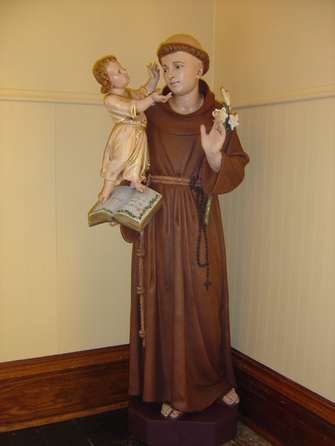

Saint Teresa of Avila
Biography St Teresa Avila St Teresa of Avila (Teresa de Cepeda y Ahumada) was born in Avila, Spain on 15th March 1515. Her parents were both pious Catholics and in some ways inspired their daughter to take up a life of prayer. As a young child Teresa showed signs of a deeply religious nature; she would often retreat into silence for prayer and would enjoy giving alms to the poor. She was very close to her Mother, who provided a warm counterbalance, to the strictness of her father. However in her teens, Teresa’s mother passed away, leaving the young Teresa distraught at the void she felt. The young St Teresa tells of her despair and how she turned instinctively to the Virgin Mary for comfort.
"I threw myself down in despair before an image of the Mother of God. With many tears, I implored the Holy Virgin to become my mother now. Uttered with the simplicity of a child, this prayer was heard. From that hour on, I never prayed to the Virgin in vain." (1)
During her later teen years Avila lost some of her early piety and religious zeal. She recounted how she became interested in worldly matters and enjoyed the company of a wide circle of friends. She had a natural charm and found it easy to make friends. In return she enjoyed the compliments and friendships of others. However, she was not at peace, considering herself to be a miserable sinner; later she would look back in guilt at her early life. However this sense of being a “miserable sinner” was probably the result of a harsh self-judgement, encouraged by her fathers exacting religious standards. At the age of 16, her father decided to send Teresa to a convent school to be educated. This re ignited in Avila an interest in following a spiritual life and after some deliberation resolved to become a nun of the Carmellite Order. At the time the convent rules were not very strict; it was probably more relaxed than living with her father. At the time the convent accepted many people into the order, often for financial reasons. The convent became overcrowded and people were often judged not on the basis of spiritual intensity but on material possessions. In this climate Teresa struggled to find time for quite reflection; although she did start teaching people on the virtues of mental prayer.
Shortly after becoming a nun, Avila experienced a severe illness (malaria), which left her in great pain for a long period. At one point it was feared that her illness was so severe that she would not be able to recover. However during this period of intense physical pain, she began to increasingly experience divine visions and an inner sense of peace. These inner experiences of joy and peace seemed to transcend the intense physical pain of the body. She describes in her own words her state of mind during these trials and tribulations
“I bore these sufferings with great composure, in fact with joy, except at first when the pain was too severe. What followed seemed to hurt less. I was completely surrendered to the will of God even if he intended to burden me like this forever..... The other sisters wondered at my God-given patience. Without him I truly could not have borne so much with so much joy.” (2)
When she was a little better she resumed her prayers with renewed vigour. However on telling others of her visions and spiritual experiences she was dissuaded from persuading them. Certain clergy felt they were just delusions of the devil. As a result, for many years Teresa lost the confidence to pursue her prayers and her spiritual life was almost put on hold. However, when Teresa was 41, she met a Priest who convinced her to go back to her prayers and implore God to come back. Initially, she had some difficulty sitting through prayers. She wryly remarked the end of the hour’s prayer couldn’t come soon enough. However, in the course of time, she became absorbed in deep contemplation in which she felt an ever growing sense of oneness with God. At times she felt overwhelmed with divine love. The experiences were so transforming, she at times felt the illumining grace of God would wash her soul away. She was so filled with divine contemplation it is said at times her body would spontaneously levitate. Teresa, however was not keen on these public displays of “miracles”. When she felt it happening she would ask other nuns to sit on her to prevent her floating away.
Teresa was not a just a quiet, placid saint. She had an endearing, natural quality; her life energy attracted and inspired many who were close. They admired her for both her outer charm and inner serenity. But at the same time her religious ecstasies also caused jealousy and suspicions. Unfortunately she was born into the period of the Spanish inquisition, during this time any deviation from the orthodox religious experience came under the strict observation and scrutiny. On one occasion Teresa complained to God about her mistreatment from so many different people. God replied to her saying “That is how I always treat my friends” with good humour St Teresa replied “That must be why you have so few friends”. St Teresa struggled because there were few who could understand or appreciate her inner ecstasies. However on the one hand she felt these experiences to be more real than ordinary events.
At the age of 43 St Teresa decided she wanted to found a new order recommitting to the values of poverty and simplicity. She wanted to move away from her present convent which made a life of prayer more difficult. Initially her aims were greeted with widespread opposition from within the town of Avila. However, with the support of some Priests, the opposition waned and she was allowed to set up her first convent. St Teresa proved to be an influential leader and founder. She guided the nuns not just through strict disciplines, but also through the power of love, and common sense. Her way was not the way of rigid asceticism and self denial. Although she underwent many tribulations herself, to others she stressed the importance of experiencing God’s love. As she herself says:
“You know, I no longer govern in the way I used to. Love does everything. I am not sure if that is because no one gives me cause to reprove her, or because I have discovered that things go better in that way." [p.657] (3)
“The important thing is not to think much but to love much and so do that which best stirs you to love. Love is not great delight but desire to please God in everything." (1)
St Teresa devoted much of the rest of her life to travelling around Spain setting up new convents based along the ancient monastic traditions. Her travels and work were not always greeted with enthusiasm, many resented her reforms and the implied criticism of existing religious orders. She often met with criticism including the papal nuncio who used the rather descriptive phrase “a restless disobedient gadabout who has gone about teaching as though she were a professor" St Teresa also had to frequently contend with difficult living conditions and her frail health. However she never let these obstacles dissuade her from her life’s task. She eventually died on October 4 at the age of 67. A fellow sister describes the hours just before the death of St Teresa.
“She remained in this position in prayer full of deep peace and great repose. Occasionally she gave some outward sign of surprise or amazement. But everything proceeded in great repose. It seemed as if she were hearing a voice which she answered. Her facial expression was so wondrously changed that it looked like a celestial body to us. Thus immersed in prayer, happy and smiling, she went out of this world into eternal life.” (2)
St Teresa Avila was one of the great Christian mystics. Overcoming physical ailments, she became fully absorbed in her devoted to God. As Sri Chinmoy says:
“In Spain, Teresa of Avila offered to the world something profoundly mystical. Her mystical experience is the most successful culmination of the divine marriage between the aspiring soul and the liberating Christ, and it is here that man’s helpless crying will and God’s omnipotent all-fulfilling Will embrace each other.” (5)
Works of Teresa of Avila In 1566 she wrote Camino de perfeccion (Way of Perfection) in about 1566, to tell the nuns how to reach their goal;
In 1580 she wrote what is considered her greatest work; the Castillo interior/ Las moradas (Interior castle/ The mansions) this involved describing the various stages of spiritual evolution leading to full prayer; she wrote Las Fundaciones (Foundations) from 1573 to 1582, so they would remember the early history of their order.
Her ways
Poetry of St Teresa Avila St Teresa wrote several volumes of poetry her most popular (4) [p.33]
"God alone is enough." Let nothing upset you,
let nothing startle you.
All things pass;
God does not change.
Patience wins
all it seeks.
Whoever has God
lacks nothing:
God alone is enough.
St. Therese, "The Little Flower"
Therese Martin was the last of nine children born to Louis and Zelie Martin on January 2, 1873, in Alencon, France. However, only five of these children lived to reach adulthood. Precocious and sensitive, Therese needed much attention. Her mother died when she was 4 years old. As a result, her father and sisters babied young Therese. She had a spirit that wanted everything.
At the age of 14, on Christmas Eve in 1886, Therese had a conversion that transformed her life. From then on, her powerful energy and sensitive spirit were turned toward love, instead of keeping herself happy. At 15, she entered the Carmelite convent in Lisieux to give her whole life to God. She took the religious name Sister Therese of the Child Jesus and the Holy Face. Living a hidden, simple life of prayer, she was gifted with great intimacy with God. Through sickness and dark nights of doubt and fear, she remained faithful to God, rooted in His merciful love. After a long struggle with tuberculosis, she died on September 30, 1897, at the age of 24. Her last words were the story of her life: "My God, I love You!"
The world came to know Therese through her autobiography, "Story of a Soul". She described her life as a "little way of spiritual childhood." She lived each day with an unshakable confidence in God's love. "What matters in life," she wrote, "is not great deeds, but great love." Therese lived and taught a spirituality of attending to everyone and everything well and with love. She believed that just as a child becomes enamored with what is before her, we should also have a childlike focus and totally attentive love. Therese's spirituality is of doing the ordinary, with extraordinary love.
She loved flowers and saw herself as the "little flower of Jesus," who gave glory to God by just being her beautiful little self among all the other flowers in God's garden. Because of this beautiful analogy, the title "little flower" remained with St. Therese.
Her inspiration and powerful presence from heaven touched many people very quickly. She was canonized by Pope Pius XI on May 17, 1925. Had she lived, she would have been only 52 years old when she was declared a Saint.
"My mission - to make God loved - will begin after my death," she said. "I will spend my heaven doing good on earth. I will let fall a shower of roses." Roses have been described and experienced as Saint Therese's signature. Countless millions have been touched by her intercession and imitate her "little way." She has been acclaimed "the greatest saint of modern times." In 1997, Pope John Paul II declared St. Therese a Doctor of the Church - the only Doctor of his pontificate - in tribute to the powerful way her spirituality has influenced people all over the world.
